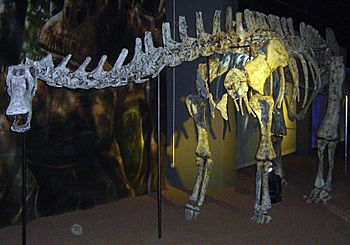Limaysaurus facts for kids
Quick facts for kids Limaysaurus |
|
|---|---|
 |
|
| Skeleton restoration | |
| Scientific classification |
|
| Kingdom: | Animalia |
| Phylum: | Chordata |
| Clade: | Dinosauria |
| Clade: | Saurischia |
| Suborder: | †Sauropodomorpha |
| Clade: | †Sauropoda |
| Family: | †Rebbachisauridae |
| Subfamily: | †Limaysaurinae |
| Genus: | †Limaysaurus Salgado et al., 2004 |
| Type species | |
| †Limaysaurus tessonei Calvo & Salgado, 1995
|
|
| Synonyms | |
|
|
Limaysaurus was a type of plant-eating dinosaur that lived a long, long time ago in what is now Argentina. It belonged to a group of dinosaurs called sauropods, which were known for their very long necks and tails, and their huge bodies. Limaysaurus was a herbivore, meaning it only ate plants.
Contents
Limaysaurus: The Gentle Giant
Limaysaurus was a large dinosaur, measuring about 15 to 18 meters (around 50 to 60 feet) long. That's longer than two school buses! It likely weighed around 7 to 10 tons, which is as heavy as a few elephants. Like other sauropods, it walked on four thick, strong legs. Its long neck helped it reach high branches, and its long tail helped it balance.
What Was Limaysaurus?
Limaysaurus was part of a special family of sauropods called rebbachisaurids. These dinosaurs often had unique teeth that were good for stripping leaves off plants. They were different from some other sauropods because they had a lower, flatter skull. Scientists believe rebbachisaurids might have eaten plants that grew closer to the ground, or they might have used their special teeth to get leaves from trees.
Where and When Did It Live?
This amazing dinosaur lived during the Cretaceous Period, specifically in the Cenomanian age, about 99 to 93 million years ago. This was a time when many different kinds of dinosaurs roamed the Earth. Limaysaurus fossils have been found in Argentina, in South America. Back then, this area was likely a lush environment with many plants for dinosaurs to eat.
What Did It Eat?
As a herbivore, Limaysaurus spent its days eating plants. With its long neck, it could reach leaves from tall trees. Its teeth were probably shaped to help it strip leaves and other plant material. Like many large herbivores, it would have needed to eat a huge amount of plants every day to fuel its massive body.
How Was It Discovered?
The first fossils of Limaysaurus were found in Argentina. It was first described in 1995 by paleontologists Rodolfo Coria and Leonardo Salgado. They named it Rebbachisaurus tessonei at first. Later, in 2004, Leonardo Salgado and his team decided it was different enough to be placed in its own genus, so they renamed it Limaysaurus tessonei. The name Limaysaurus comes from the Limay River in Argentina, near where its fossils were found. The species name tessonei honors the Tessone family, who helped find the first fossils.
Images for kids
-
Skeleton viewed from above, National Technical University of Athens, Greece
-
Head and neck of a Limaysaurus tessonei in front of a Giganotosaurus
See also
 In Spanish: Limaysaurus tessonei para niños
In Spanish: Limaysaurus tessonei para niños



